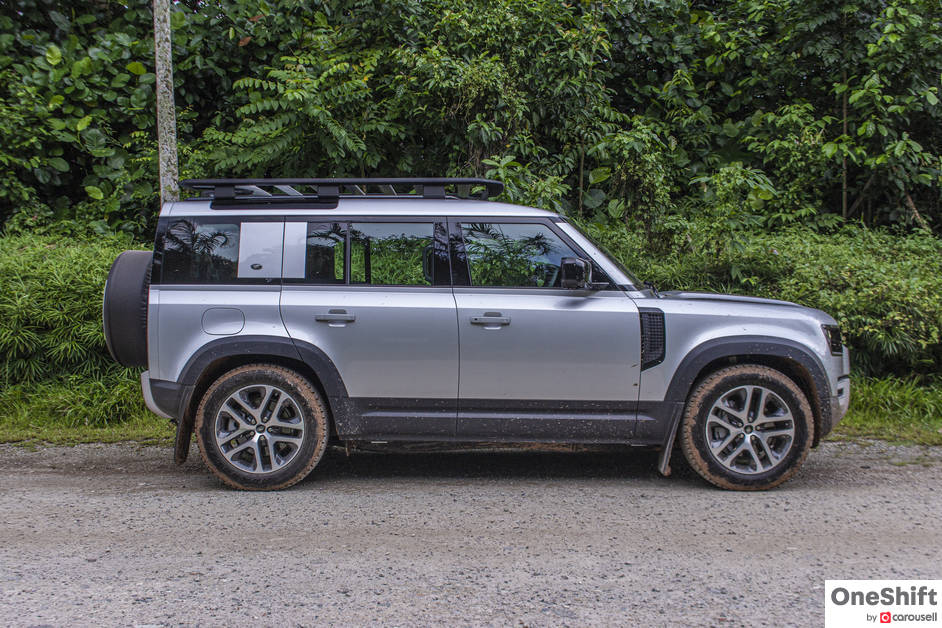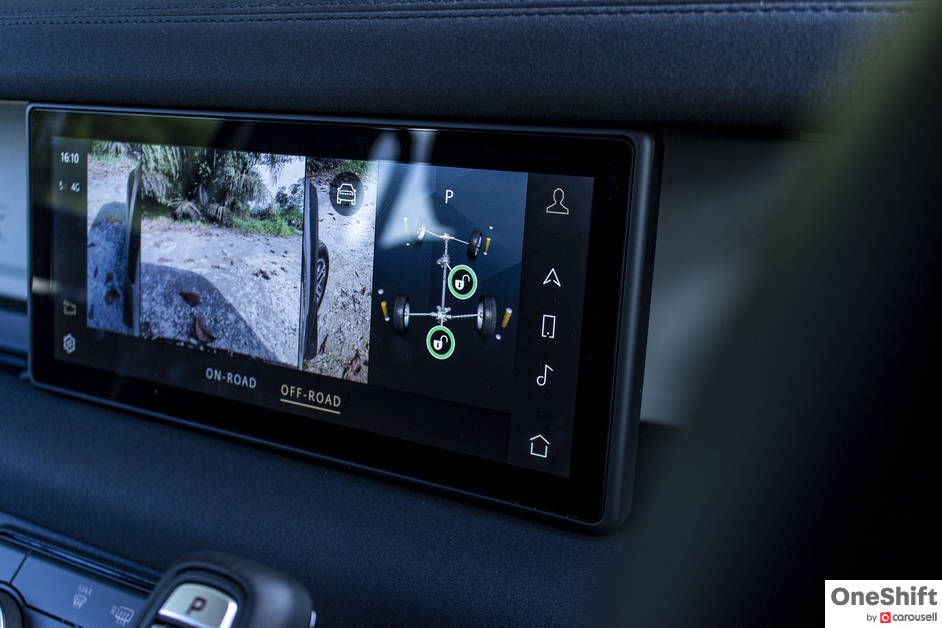Civil Defender
Who says money can’t buy happiness?! Land Rover seems to have found that sweet spot in building us a true off-roader with very good road manners... and it is fit to wear the Defender badge.


We can make no mistake that the Defender and its forefathers put the Land Rover brand onto the map. In-fact many Land Rover staffers can even stake claim that the very first car that people have seen in the undeveloped world would have been a Land Rover.

So smitten was I with my very first brush with the near-broken one in the movie ‘The Gods Must Be Crazy’, the brand had left an impression in my growing years… further bolstered by ‘Camel Trophy’ TV commercials; where adventurous folk, tough-as-nails, would bash through dense jungle in their iconic beast, skinned in the finest of riveted aluminium bodywork. Most of us guys would have also encountered the Defender, and the more senior of us, the Series models, during our time in military service.
But alas, after close to 70 years and more than 2-million built, and after heaps of updates to keep their beloved off-roader modern, Land Rover had to close this storied chapter. Plenty of this is thanks to reasons of modern safety requirements. I would dare bet that they would have carried on if not for such legislation.

The all-new Land Rover Defender may carry the badge of its predecessor, but badge aside, it is truly a very different animal. In-fact, the massive jump in price would place this in quite a different market segment. Not an easy decision made by the British automotive brand, since they decided to ditch their original DC100 concept, which would have been more attainable, in favour of a more complex vehicle, which is not only loaded with creature-comfort bells and whistles, but would almost make the average driver an off-roading whiz.

We liked that Land Rover had kept true to its original form when designing the Defender, with its unmistakable vertical silhouette, which would look so at home on the top of a sand dune, against a desert setting sun. Designers have carried over some of the styling cues first seen on the original icon, like ring headlamps, which feature LED daytime running lights, a flat bonnet, with a hump in the middle, a characteristic shoulder line and a rear door-mounted spare are features that connect with the original Defender DNA. Land Rover even retained those unique alpine windows, as-well-as the Defender’s unique model numbering system. Our test car is the smack-in-the-middle 110 model (that is, if they do build the 130).

Elements like it's incredibly short front and rear overhangs, and a 20mm higher placement of the body, compared to the rest of the Land Rover range, are functional parts of the Defender’s design, intended to ensure that the wheels can hit the dirt at a 38-degree angle of approach, and departure at 40-degrees.
Underneath the skin, the new Defender ditches the traditional ladder chassis, in favour of their new D7x architecture, a revised version of what underpins the likes of the Range Rover Sport.
Land Rover has put plenty of thought into the interior design of the Defender. A robust rubberised floor means that you can hop in and out the Defender, just about anywhere without worries, since it is designed to be easily brushed or wiped down. They have also claimed that materials, many which are soft-touch, used on the dash are made to stand the test of time. We also appreciate practical storage space built right into the dash, and available around the vehicle’s interior.

The new Defender is also available in various seating configurations, with our test car, accommodating seven in 2-3-2 format (the rear seating is best described as +2). Wearnes Automotive the dealership here, did however mention that our car would only be available on a per-indent basis. The car which they currently have on offer though, is a five-seater ‘First Edition’ variant. You can even opt for an extra +1 seat format, where the "jump seat" will fit right between the driver and front passenger, reminiscent of the original series Land Rover; though this will be available on the less powerful 2.0 litre model, which will be available at a later date. The pricer First Edition model is also equipped with one of my favourite features, a built-in refrigerator (not one with an air-conditioning duct blowing into a compartment, but an actual fridge) sited within the front console.

Land Rover has also introduced their all new Pivi Pro Infotainment system, which is a massive improvement over what is currently offered throughout the Jaguar Land Rover range. The infotainment system is powered by high performance Snapdragon processors, similar to what you may find in some mobile devices. We like that Land Rover has stuck to just one 10” touchscreen with the Defender, meaning that you need not hunt around to adjust certain features. The Defender also features a panel of buttons, allowing you easily find and to toggle settings like the car’s ride height, and even the various off and on-road drive modes, making operating the car just so much easier.

Connectivity for both Apple and Android devices is supported, though non-wireless. There is a wireless phone charger to keep your mobile juiced up throughout your offroading adventure… so that you can IG your way to off-roading godliness… you bloody showoff!

Since the Defender is built to haul plenty, designers have also included their ClearSight interior rear view mirror, like the one found in the Range Rover Evoque, so that if your view is blocked by your cargo, the roof-mounted rear camera can take over rear mirror duties at a flick of a switch, with the mirror cleverly turning into the rear display.

On the subject of space, the Defender boasts up to 1,075 litres (if you stow up to the roofline) in five-seater mode, and up to 2,380 with the middle row folded.
For Singapore, the Defender gets two engine choices, the P400 Mild Hybrid (MHEV) in-line six-cylinder Ingenium petrol unit, fitted with a conventional turbocharger and an advanced 48-volt electric supercharger, which is what is in our test car; and a more affordable 2.0 litre P300 Ingenium four-cylinder.

The larger engine with the Mild Hybrid system would be the preferred choice, since the Defender is built for some serious off-roading duties. Power is rated at 400ps, while its maximum torque of 550Nm, which is delivered rapidly, initially via the electric supercharger, and peaks at 2,000rpm, ensures that there is no lack of drive available, even in challenging conditions.

The 48-volt battery of the mild hybrid powertrain does the duties of powering all other electric accessories within the car, ensuring that the engine can focus more on what it is intended for, which is to drive all of the Defender’s hefty 2,361kg of drivetrain, bells and whistles and the occasional odd clueless non-offroad-seasoned driver… this is by no means a light car at all. Drive to the wheels is via an 8-speed ZF 8HP family transmission, which is coupled to a 2-speed transfer case.

We like that the electric supercharger comes into play earlier in the game, which ensures that the Defender does a wonderful job of lugging itself from the lights, and hitting the benchmark 100km/h in only 6.1 seconds. However at slower “car park” speeds, there is a little bit of jerkiness in the drive, which mars an otherwise near-excellent driving experience.

Ride comfort is definitely worlds apart from the original car, since the new Defender is equipped with a fully independent suspension, and delivers car-like road manners. I particularly like the steering and brakes, the latter which is surprisingly accurate (especially given the Defender’s weight). If you are expecting a vehicle which communicates its ruggardness to the interior, you could be far from right, as it does deliver an impressively refined ride.

Turn the Defender off the main road, and drive it onto uncharted surfaces, inclines, mud, tall grass… which was what we decided to do. The patented Terrain Response system allows you to decide which driving mode is best-suited for the conditions you are in, with the controls available on the Pivi Pro touchscreen. You can even fine-tune how the car reacts, by locking and unlocking your axles on-screen. For those who are just beginning to experience the joys of true offroading, the system can even decide what is best for you. When the need arises, the air suspension system can raise the body to a maximum of 145mm, great when you are thinking about fording through a stream… for that, the Defender can wade to a depth of 900mm.


One of the features that sets the Defender apart from the average SUV is in its wheel articulation, where you will get 500mm of suspension play, allowing for better traction, where most SUV wheels would fail to extend to; allowing you to tackle 45 degree side slopes and inclines. While you are doing this, you can take advantage of the ClearSight Ground View to see where your wheels are going, reducing significantly the number of times your spotter will need to exit the vehicle.

While it is an accomplished off-roader, the Defender would be first for you - a road car, and that is where it does shine as well. Sure, it is not as upscale as the Mercedes-Benz GLE, or the BMW X5 (both which are also 5+2 seater SUVs). But there is a lot that a Defender can do, that the competition is not able to.

I would say that the new Defender is the brand’s most important vehicle of the decade, and while it would set you back around a hefty $315k, sans a whole list of costly original and aftermarket upgrades, you will definitely find plenty of joy driving it around, and looking for paths less beaten… Dirty or clean, the Defender does look good both ways sitting on your porch.
Who says money can’t buy happiness?!

Remember that earlier-mentioned DC100 concept? The new Defender has now left a white space for this simpler car to actually exist. Perhaps in Land Rover model nomenclature…. A “Defender Sport”?
Credits: Words and Photos by Clifford Chow







- Convenient and Hassle-Free
- Consumer Protection
Transparent Process
With No Obligation


Get the Best Price for your used car
from 500+ dealers in 24 hours








